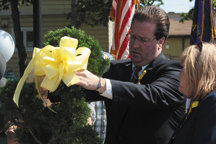Douglas O’Neill and three other soldiers lifted off in a U.S. Army helicopter from Marble Mountain Airfield in Danang, one of the key American military bases in Central Vietnam, on April 3, 1972.
Twenty-four years old at the time, O’Neill had achieved one of his childhood dreams – to fly. Since his enlistment in the Army in 1968 he had risen to the rank of chief warrant officer. He belonged to that rare breed of brave men who hovered over the jungle, dangerously exposed to enemy fire, supporting troops on the ground, or carrying out seriously wounded troops in lifesaving operations.
Since arriving in Vietnam in October 1971, O’Neill had already exceeded some of his dreams, even going so far as to serve in the honor guard for President Thieu of South Vietnam.
At 9:45 a.m. on April 3, the radar installation reported O’Neill was flying his copter under “Visual Flight Rules” above the cloud cover in the general vicinity of Quang Tri City. These rules allow a pilot to operate the craft in weather conditions where there is significant visibility. O’Neill, however, requested radar vectors, and radar operators believed he might be off course.
“As this tree flourishes and grows, we will not allow our little ones to forget the sacrifices made by heroes.” – Mayor Mark Smith
________
The Army searched the area between Highway 1 and the coast, but could not find any wreckage. The four men, including O’Neill, were listed as missing in action, and later the Secretary of the Army approved listing them as dead.
In Bayonne, a city that has the distinction of having the largest percentage per capita in the country of men who died in Vietnam, O’Neill stands out as the only soldier unaccounted for, a nagging symbol of the more than 1,723 nationwide missing in action.
But this year, new hope of finding O’Neill’s remains has surfaced, according to James Newby of the VFW Post 19. He said at the POW/MIA Remembrance Day on Sept. 25 that a new search is planned to find O’Neill’s remains as well as those of his three companions.
The tree died, but not hope
This news made the ceremony this year in Fitzpatrick Park that much more poignant, because it provided a ray of hope to those who keep vigil here.
Although the tree planted here on behalf of those missing or believed to be prisoners of war has died several times since first being planted in 1987, the hope in the hearts of those who yearly gather at the location has not.
While soldiers had been declared missing in previous wars in the 20th century, the POW/MIA movement rose out of fears that some of the missing during the Vietnam War were being held prisoner, and that the American government was doing too little to account for their fate. This movement is credited with altering American military policy in the current wars in Iraq and Afghanistan, where no soldier is allowed to go unaccounted for.
“September is National POW/MIA Month,” said Roberta Buchanan, president of the American Legion Auxiliary Post Unit 19. “It is a month dedicated to the 88,000 since World War II that have yet to come home. Forgetting these heroes is not an option. Generations to come, we must continue until every one of these troops is accounted for and back on American soil. Progress has been made over the last few years through different programs, but we have a long way to go. Educating the next generation assures these heroes will not be forgotten and the search will continue.”
Part of the ceremony explains the significance of the different elements in the familiar black and white POW/MIA flag.
The flag, which was flown over many state capitals during the 1980s in solidarity with the movement, shows a silhouette of a man in front of barbed wire and a guard tower, with the words “POW-MIA” and, “You are not forgotten.”
A day is set aside for ceremonies like this
As part of the movement, a POW/MIA Recognition Day is held each year, usually on the third Friday in September, and is one of six days mandated by Congress on which the black POW/MIA flag must be flown over federal facilities and cemeteries, post offices, and military installations.
Debra Nobel, chairperson of the ceremony, said the vigil was held at the park for about 15 years, and then brought to the post. Last year, the ceremony returned to the park, where the original tree was found dying.
The city replaced the tree during the last year, but it faltered again, and a few days prior to this year’s event, the city planted a new evergreen in its place.
Although sparsely attended, this year’s ceremony drew a few dozen people, including Mayor Mark Smith; Assemblyman Jason O’Donnell; and council members Terrence Ruane, Debra Czierwinski, Agnes Gillespie, Joseph Hurley, and Raymond Greaves, as well as national, state, and local representatives of the American Legion and its auxiliary.
“As this tree flourishes and grows, we will not allow our little ones to forget the sacrifices made by heroes, veterans of our wars past, and the people who are still serving our country today,” Mayor Smith said.
Al Sullivan may be reached at asullivan@hudsonreporter.com.
